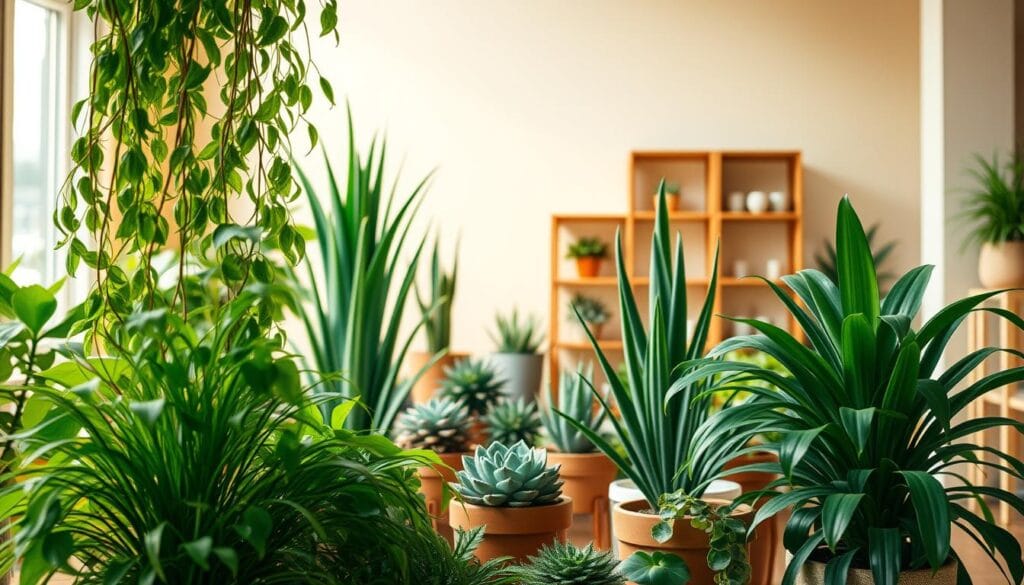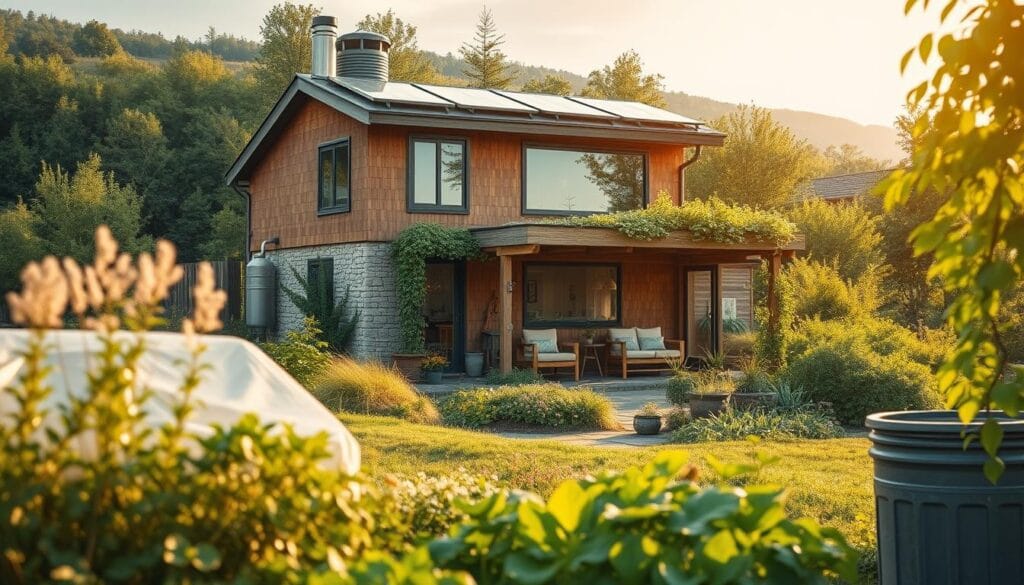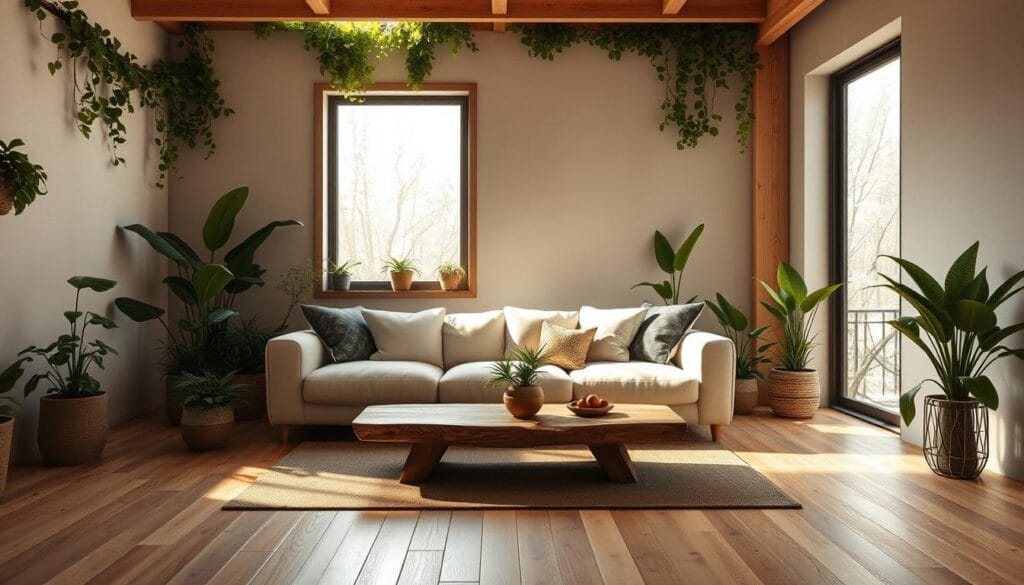Have you ever walked into a room and instantly felt at ease? Chances are, it had something to do with the plants and natural elements around you. There’s something magical about having a touch of nature in your home—it’s like a breath of fresh air, literally and figuratively.
More than just a trend, biophilic design is about creating spaces that nurture our connection to nature. Studies show that incorporating indoor plants can reduce stress, boost creativity, and even improve air quality. It’s no wonder so many of us are turning our homes into calming oases filled with greenery.
In this article, we’ll explore how to seamlessly blend design and nature, from choosing the right plants to styling your space with a garden vibe. Whether you’re a seasoned plant parent or just starting out, you’ll find inspiration to make your home a sanctuary of peace and beauty.
Welcome to Your Natural Oasis
Your home can be more than just a place—it can be a sanctuary of serenity. By blending interior design with natural elements, you can create a space that feels alive and calming. It’s about more than aesthetics; it’s about fostering a connection to nature that enhances your well-being.
Understanding the Connection Between Home and Nature
Think about how natural light streaming through a window can instantly lift your mood. Or how fresh air from an open space can make you feel more at ease. These are simple yet powerful ways to bring the outdoors inside. In urban environments like London or Turnbridge Wells, where green spaces are limited, creating a natural oasis at home becomes even more essential.
Studies show that incorporating plants and natural elements into your space can reduce stress by up to 30%. It’s not just about adding greenery; it’s about designing a harmonious environment that nurtures your mind and body.
Why Eco-Conscious Design Matters Now
Eco-conscious design isn’t just a trend—it’s a necessity. Simple adjustments, like choosing sustainable materials or improving air quality with plants, can make a big difference. For example, plants like the Snake Plant and Peace Lily are known to filter harmful toxins, creating a healthier environment.
By embracing eco-friendly practices, you’re not just enhancing your home; you’re contributing to a more sustainable future. It’s a practical, accessible way to boost your sense of peace and well-being.
The Green Renaissance: Revitalizing Your Space with Indoor Plants
The way we design our homes is evolving, and plants are taking center stage. This Green Renaissance is all about blending nature with modern design to create spaces that feel alive and inspiring. Whether you’re a seasoned plant enthusiast or just starting out, there’s never been a better time to embrace this trend.
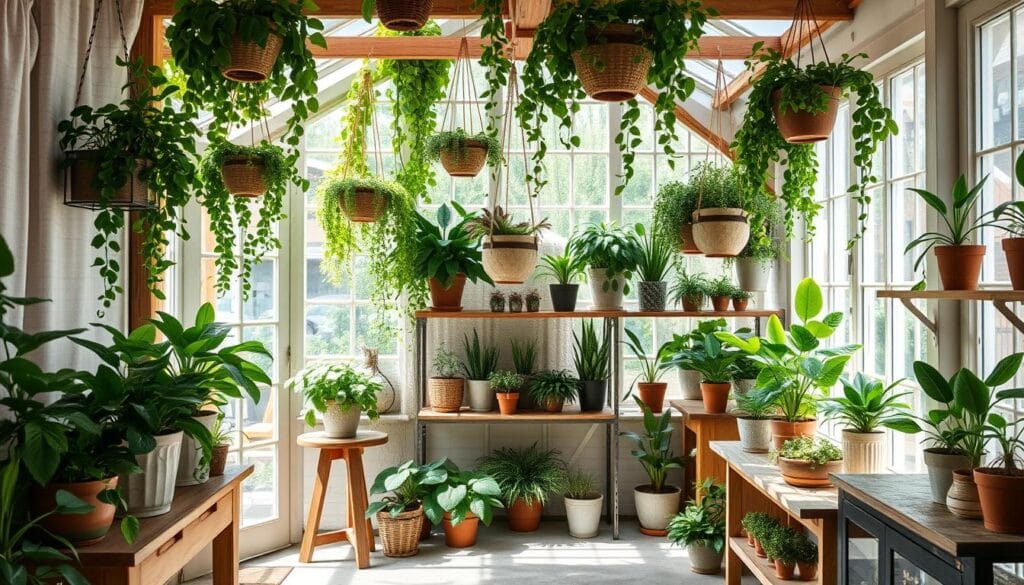
Emerging Trends for 2025
As we look ahead to 2025, certain plants are set to dominate the design scene. Fiddle-leaf figs and Monstera deliciosa are leading the way, thanks to their bold, statement-making leaves. These plants not only add visual interest but also thrive in a variety of spaces, from cozy apartments to spacious homes.
Another trend to watch is the rise of indoor plant collections. Think curated groupings of succulents, ferns, and flowering varieties. These collections allow you to experiment with textures and heights, creating a dynamic, layered look. Pair them with stylish planters for a polished finish.
Benefits for Mind, Body, and Environment
Incorporating plants into your space goes beyond aesthetics. Studies show that indoor plants can reduce stress by up to 37% and boost productivity by 90%. They also improve air quality by filtering toxins, making your home a healthier environment.
For those who love to garden, tending to plants can be a therapeutic activity. It’s a chance to slow down, connect with nature, and nurture something living. Plus, the effect of greenery on your mood is undeniable—it’s like having a little piece of the outdoors inside.
| Trend | Benefit |
|---|---|
| Fiddle-leaf figs | Statement-making, low maintenance |
| Monstera deliciosa | Air-purifying, versatile |
| Succulent collections | Textural variety, easy care |
| Curated plant groupings | Dynamic, layered design |
Ready to join the Green Renaissance? Start by choosing plants that suit your lifestyle and space. Experiment with placement, mix and match varieties, and don’t be afraid to get creative. Your home will thank you!
Bringing Nature Indoors: Eco-Conscious Ways to Decorate with Plants
Imagine stepping into a space where every corner feels alive and connected to the outdoors. This is the essence of biophilic design, a concept that emphasizes our innate connection to nature. By incorporating natural elements into every room, you can create a home that’s not only beautiful but also nurturing.
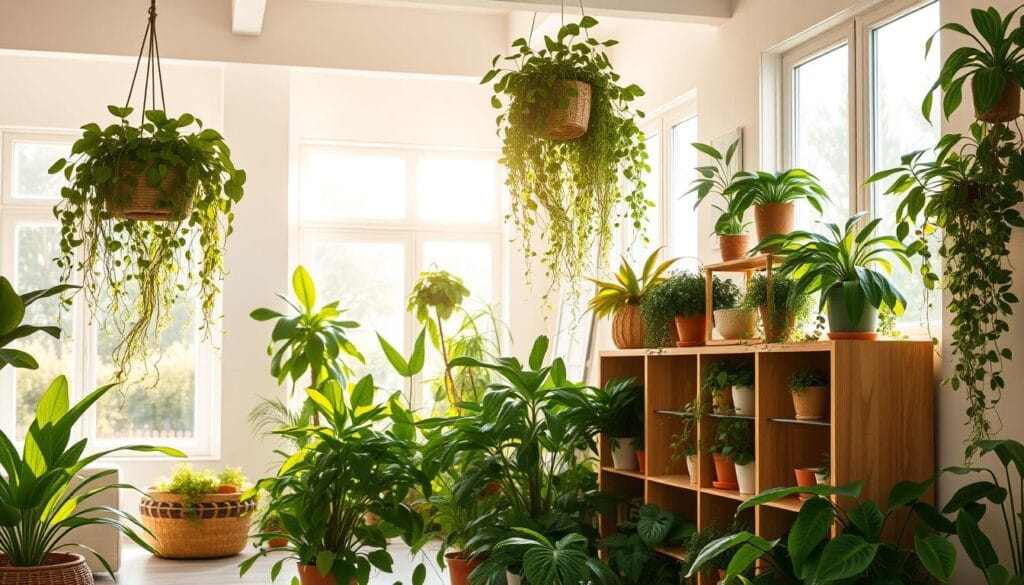
Incorporating Biophilic Principles in Every Room
Start by thinking about how you can bring the outdoors inside. Use natural materials like wood, stone, or bamboo to add texture and warmth. For example, a wooden coffee table or a stone accent wall can instantly elevate a room’s design. These elements create a sense of harmony and balance.
Another way to embrace biophilic design is through indoor plants. Plants like the Snake Plant or Peace Lily not only purify the air but also add a vibrant touch of green. Place them in geometric planters to add a modern shape to your décor.
Creative Ways to Enhance Your Space
Think beyond just plants. Use tactile textures like woven rugs or linen curtains to create a cozy, natural feel. These small details can make a big difference in how a room feels. Pair them with earthy tones for a cohesive look.
Statement features like a living wall or a water fountain can also transform your space. These additions not only look stunning but also bring the calming touch of nature indoors. For more inspiration on creating biophilic spaces, check out this guide.
Every room in your home can reflect the beauty of the outdoors. With thoughtful choices, you can create a space that’s both stylish and deeply connected to nature.
Optimizing Small Spaces with Creative Green Solutions
Small spaces don’t have to limit your creativity—they can inspire it. With the right design, even the tiniest corners can become lush, vibrant retreats. Let’s explore how to maximize greenery in compact areas without sacrificing style.
Vertical Gardens and Hanging Plants
When floor space is limited, think upwards. Vertical gardens are a game-changer for small rooms. They not only save space but also add a stunning visual element. Plants like pothos, ferns, and ivy thrive in vertical setups.
Hanging plants are another great way to bring life to your space. Use macramé hangers or wall-mounted planters to create a cascading effect. This approach adds depth and charm to any room.
Compact Planters and Multi-Use Fixtures
Choosing the right planters is key. Opt for compact designs that fit snugly on shelves or windowsills. Materials like wood or ceramic add warmth and texture while being sustainable.
Multi-use fixtures, like plant stands with storage, are both functional and stylish. They maximize space while keeping your indoor garden organized. Pair them with air-purifying plants for added benefits.
By incorporating these creative solutions, you can transform even the smallest areas into green havens. It’s a way to add energy and charm to your home, one plant at a time.
Sustainable Interior Design: Enhancing Your Home’s Eco-Friendliness
Sustainable design is more than a trend—it’s a lifestyle choice that benefits both your home and the planet. By making thoughtful choices in materials and design, you can create a space that’s both stylish and environmentally responsible. Let’s explore how to enhance your interior design with eco-friendly practices.
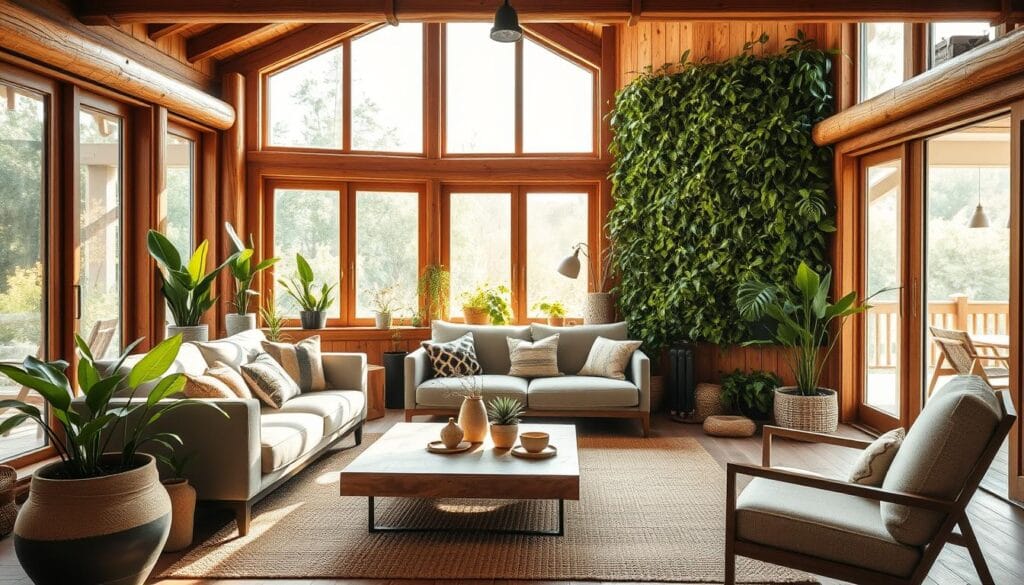
Choosing Locally Sourced and Eco-Friendly Materials
One of the easiest ways to embrace sustainability is by selecting locally sourced materials. This reduces transportation emissions and supports regional economies. For example, wood from responsibly managed forests is a great choice for furniture and flooring. It’s durable, timeless, and adds warmth to any home.
Another option is bamboo, a fast-growing resource that’s both sustainable and versatile. Use it for furniture, flooring, or even indoor planters. Cork is another eco-friendly material, harvested without harming the tree. It’s perfect for flooring, tiles, and furniture.
Here are some tips for choosing sustainable materials:
- Opt for quality over quantity—invest in pieces that last.
- Choose biodegradable indoor planters made from materials like coconut coir or recycled paper.
- Look for certifications like FSC (Forest Stewardship Council) for wood products.
Incorporating these materials not only enhances your design but also reduces your environmental footprint. It’s a win-win for your home and the planet.
How Plants Improve Air Quality and Well-Being
Indoor plants are more than just decorative—they’re natural air purifiers. Plants like the Snake Plant and Peace Lily filter harmful toxins, improving air quality and creating a healthier environment. Studies show that they can reduce stress and boost productivity, making them a must-have for any home.
Place them in areas where you spend the most time, like the living room or home office. Pair them with stylish, eco-friendly planters to complete the look. Not only do they enhance your interior design, but they also bring a touch of nature indoors.
Here’s how to maximize their benefits:
- Group plants together to create a mini indoor garden.
- Choose low-maintenance varieties if you’re new to plant care.
- Use natural elements like pebbles or moss to decorate planters.
By incorporating these practices, you can create a home that’s not only beautiful but also eco-conscious. Sustainable design is about making choices that benefit you and the environment—one step at a time.
Modern Interior Styling: Integrating Minimalism with Living Elements
Minimalism meets warmth in modern interior styling, creating spaces that feel both sleek and inviting. By blending clean lines with natural textures, you can achieve a design that’s both modern and grounded. It’s about finding the perfect balance between simplicity and connection to nature.
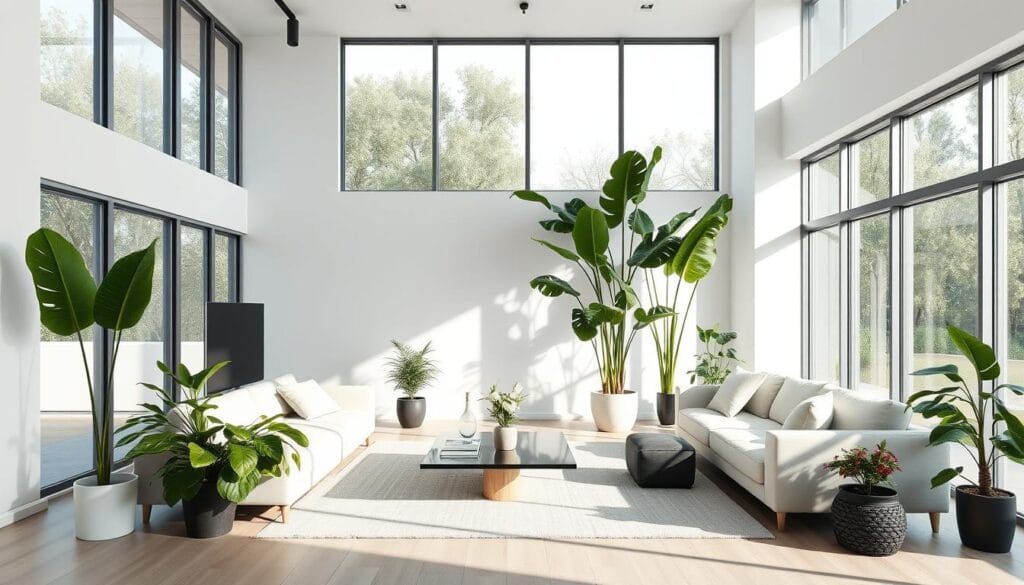
Using Monochromatic Palettes with Natural Textures
Monochromatic color schemes are a cornerstone of modern design. Think soft grays, warm whites, and muted beiges. These tones create a calming environment while allowing natural textures to shine. Pair them with materials like wood, linen, or stone for added depth.
For example, a beige sofa with a woven throw or a wooden coffee table can add warmth to a neutral space. These elements bring a tactile quality that makes the room feel cozy and lived-in. It’s a subtle way to enhance aesthetics without overwhelming the senses.
Geometric Planters as Statement Accents
Geometric planters are a game-changer in modern interior design. Their clean lines and unique shapes make them perfect statement pieces. Place them in corners or on shelves to add a touch of greenery without cluttering the space.
Pair these planters with low-maintenance plants like succulents or snake plants. Their structured forms complement the minimalist vibe while adding a living element to the room. It’s a simple yet impactful way to elevate your design.
| Design Element | Impact |
|---|---|
| Monochromatic Palette | Creates a calming, cohesive look |
| Natural Textures | Adds warmth and tactile appeal |
| Geometric Planters | Provides a modern, artistic touch |
| Low-Maintenance Plants | Brings life without extra effort |
Ready to transform your space? Start with a neutral base, layer in natural textures, and add geometric planters for a modern yet inviting look. Your home will feel like a perfect blend of design and connection to nature.
Indoor Plants for Productive Spaces and Well-Being
Ever wondered how a simple plant can transform your workspace into a hub of productivity? Research shows that incorporating greenery into your living space can boost focus, creativity, and overall well-being. Whether you’re working from home or in an office, the right indoor plants can make a world of difference.
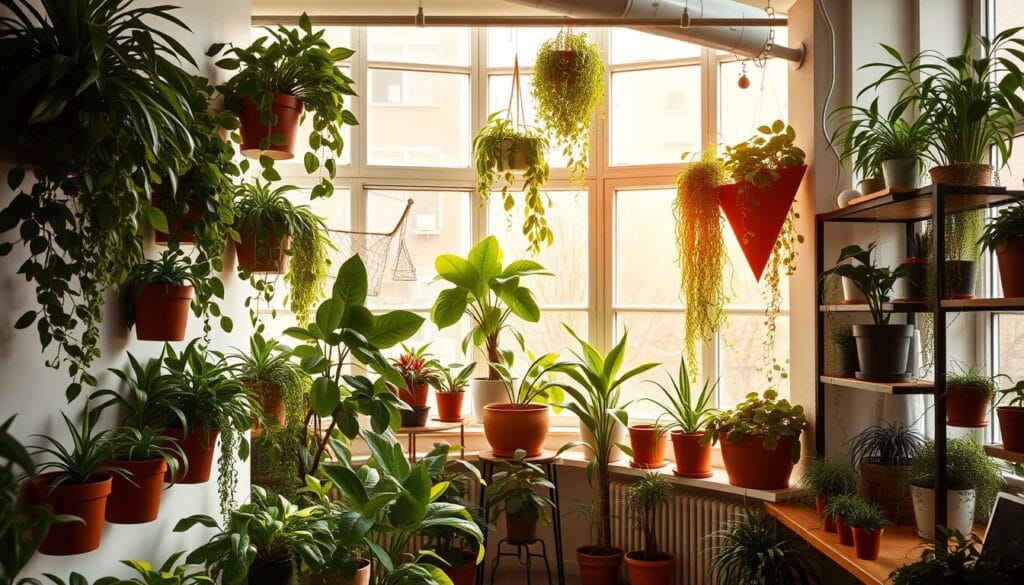
Plants That Boost Focus in Workspaces
Not all plants are created equal when it comes to enhancing productivity. Some varieties are particularly effective at improving focus and reducing stress. For example, the Snake Plant is known for its air-purifying qualities and ability to thrive in low light. Similarly, the Peace Lily not only adds a touch of elegance but also filters harmful toxins from the air.
Here are a few other plants that can elevate your workspace:
- Spider Plant: Easy to care for and excellent at improving air quality.
- Rubber Plant: Its large leaves add a bold statement while boosting humidity.
- Pothos: A low-maintenance option that thrives in various lighting conditions.
“The presence of plants in a workspace can increase productivity by up to 15%, according to a study from the University of Exeter.”
The Energy and Psychological Effects of Greenery
Adding plants to your workspace does more than improve air quality—it also has a profound effect on your mental state. Studies show that being surrounded by greenery can reduce stress by up to 37% and enhance creativity by 15%. This is because plants create a calming environment that fosters a deeper connection to nature.
For those who spend long hours at a desk, plants can also reduce eye strain and provide a refreshing visual break. Their natural beauty adds a sense of tranquility, making your space feel more inviting and energizing.
Styling Tips for Workspace Plants
Incorporating plants into your workspace doesn’t mean sacrificing style. Here are some tips to keep your design sleek and functional:
- Use geometric planters to add a modern touch.
- Place plants on shelves or desks to maximize space.
- Group smaller plants together for a lush, layered look.
By thoughtfully selecting and arranging your indoor plants, you can create a workspace that’s both productive and beautiful. It’s a simple yet powerful way to enhance your well-being and stay connected to nature.
Essential Indoor Plant Care and Maintenance Tips
Keeping your indoor plants healthy doesn’t have to be complicated. With a few simple practices, you can ensure they thrive and bring life to your interior design. Let’s dive into the essentials of watering, lighting, and pruning to keep your greenery vibrant year-round.
Watering, Lighting, and Pruning Best Practices
Watering is one of the most critical aspects of plant care. Overwatering can lead to root rot, while underwatering can cause dehydration. Check the soil moisture before watering—stick your finger about an inch deep. If it’s dry, it’s time to water. For most plants, watering every 1-2 weeks works well.
Light is another key element. Most indoor plants thrive in bright, indirect light. Place them near a window where they can get filtered sunlight. Low-light varieties like snake plants and pothos can adapt to shadier spots.
Pruning helps maintain your plant’s shape and health. Remove dead or yellowing leaves regularly to encourage new growth. Use clean, sharp scissors to avoid damaging the plant.
Tools and Self-Watering Options
Investing in the right tools can make plant care easier. A moisture meter helps you gauge when to water, while a spray bottle is perfect for misting tropical plants. For those with busy schedules, self-watering planters are a game-changer. They provide consistent moisture, reducing the risk of over or underwatering.
Here’s a quick guide to essential tools:
| Tool | Purpose |
|---|---|
| Moisture Meter | Measures soil moisture levels |
| Spray Bottle | Mists leaves for humidity |
| Self-Watering Planter | Provides consistent watering |
| Pruning Shears | Trims dead or overgrown leaves |
By following these tips, you can create a thriving indoor garden that enhances your design and improves air quality. For more inspiration, check out our home design ideas.
Creating Indoor Gardens: Combining Multiple Plants for a Lush Ambience
Transform your home into a vibrant oasis with lush indoor gardens. By layering plants of varying heights and textures, you can create a dynamic space that feels alive and inviting. This approach not only enhances your design but also brings a sense of calm and connection to nature.
Layered Planting and Textural Variety
Start by selecting plants with different heights and leaf shapes. Tall plants like fiddle-leaf figs add vertical interest, while trailing varieties like pothos soften edges. Mix in medium-sized plants like snake plants for balance. This layering technique creates depth and makes your garden visually stunning.
Textural variety is key to a captivating indoor garden. Combine smooth, glossy leaves with rough, textured ones for contrast. For example, pair a rubber plant’s bold foliage with the delicate fronds of a fern. This mix adds life and dimension to your space.
Creative Grouping and Decorative Elements
Group plants with similar care needs to simplify maintenance. For instance, cluster succulents together in a sunny spot or group humidity-loving ferns in a bathroom. This not only ensures their health but also creates cohesive design zones.
Decorative elements like unique planters can elevate your indoor garden. Choose geometric or handcrafted pots to add personality. Place them on shelves, tables, or even hang them to maximize space. These details make your garden a focal point in any room.
By thoughtfully combining plants and textures, you can create an indoor garden that enriches your home’s ambiance. It’s a simple yet powerful way to bring nature indoors and enjoy its calming effect every day.
Conclusion
Transforming your home into a calming retreat is easier than you think. By adding natural elements, you can create a sense of peace and improve your well-being. Studies show that greenery enhances air quality and reduces stress, making your space healthier and more inviting.
From a single plant to a full indoor garden, small changes can make a big difference. Use natural light to brighten your rooms and bring the outdoors inside. Pair earthy textures with modern design for a harmonious look.
We encourage you to experiment with these ideas. Whether it’s a touch of greenery or a complete redesign, your home can become a sanctuary of calm. Start today and feel the connection to nature transform your daily life.

